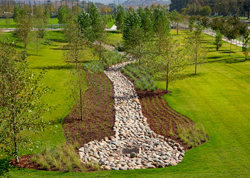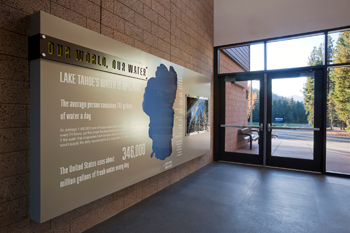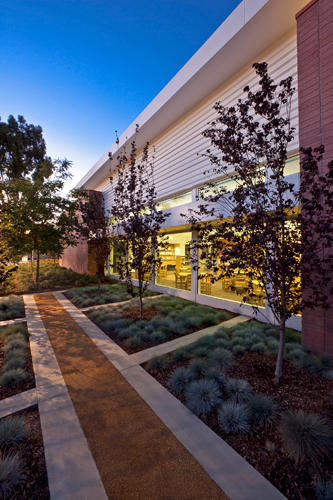Sustainable Planning and Design in K-12 Schools: Part 1
The many planning, design, technology, and other strategies to green a new or existing school are too numerous to list in a single post, and they are growing exponentially on a daily basis. The following are just some of the basic, cost-effective sustainable planning and design strategies that we’ve learned by applying our 10 Sustainable Principles to k-12 schools.
Landscape architecture is one of the most important and cost-effective tools for creating a green school and campus. Trees, flowers, shrubs, hedges, and native grasses cost far less than the mechanical systems, building materials, and infrastructure that, in the past, were used to cool and insulate buildings and mitigate stormwater runoff.
First, landscape architecture can significantly reduce heat islands, which will lower HVAC requirements and costs. Heat islands are asphalt and other dark, non-reflective surfaces on roofs, walkways, roads, and parking lots that absorb and slowly release heat throughout the day and into the night, which can raise surrounding temperatures by as much as 10 degrees. Heat islands make buildings hotter, which means greater air conditioning use and energy consumption.
A green screen—a metal lattice planted with vines and/or climbing flowers—along a building’s western façade, for example, will lessen that heat island and limit interior heat absorption. Placing trees along the south façade of a building will provide both shade and heat reduction in the summer. By choosing deciduous trees that drop their leaves every autumn, the building will enjoy warmth and sunlight during the cold winter months, which will reduce heating and artificial lighting usage and lower energy bills.
Trees and arbors planted around (and throughout) a surface parking lot minimize heat islands and create a shaded, attractive, even welcoming parking area.
Second, we use drought-tolerant, native plants. Once these plants are established, they’ll need little (if any) irrigation, which conserves water. They’ll also need very little maintenance, which reduces our school’s long-term operating costs.
Third, landscape architecture also manages stormwater runoff, which carries automobile contaminants from roadways and parking lots into waterways and can also lead to flooding. Strategies like bioswales— landscaped trenches or small canals that are lined with grass and plants—clean, slow, and reduce the amount of stormwater runoff from the site, while also beautifying the school.
Fourth, landscape architecture can be used to buffer noise and to screen visually unattractive items such as mechanical systems and dumpsters.
WATER CONSERVATION AND STORMWATER MANAGEMENT
Water-conserving plumbing fixtures can save tens of thousands of gallons of potable water annually. Outside, drought-tolerant and native plants also conserve water. Install a low-consumption drip irrigation system that uses recycled rather than potable water.
 An increasingly popular strategy is an Internet-based landscape irrigation system linked to weather satellites that adjusts the timing and amount of irrigation according to current weather conditions, including air temperature, precipitation, wind, and humidity.
An increasingly popular strategy is an Internet-based landscape irrigation system linked to weather satellites that adjusts the timing and amount of irrigation according to current weather conditions, including air temperature, precipitation, wind, and humidity.
Stormwater management strategies start with landscape architecture and open space, which can minimize—or even eliminate—the need for traditional stormwater management infrastructure, and that helps to reduce the school’s overall construction and operating costs. How? Open space in and of itself absorbs a good deal of stormwater.
 In addition, bioswales, natural and man-made wetlands, natural and man-made detention ponds, even a green roof all help to slow, cleanse, and store stormwater runoff, minimizing erosion, pollution, and flood risks. The plants of a green roof, for example, absorb and store rain, reducing runoff, and they also filter pollutants from rain and stormwater runoff.
In addition, bioswales, natural and man-made wetlands, natural and man-made detention ponds, even a green roof all help to slow, cleanse, and store stormwater runoff, minimizing erosion, pollution, and flood risks. The plants of a green roof, for example, absorb and store rain, reducing runoff, and they also filter pollutants from rain and stormwater runoff.
In Part Two of Sustainable Planning and Design in K-12 Schools, we’ll discuss energy, atmosphere, materials and resources. Want to do something now to start greening your campus? If you’re a parent, don’t assume. Pick up the phone and call your school district. Ask questions. If you’re a school district, the phone is your friend as well – make a few calls to learn more about the different funding sources available for your existing school facilities.
Dave Gilmore has more than 30 years of experience in the architectural design industry. A Principal at LPA Inc., Gilmore has left his mark on more than 200 K-12 schools. He has additional expertise in urban planning, commercial, retail, institutional, mixed-use and public architectural design. Dave is a LEED accredited professional (AP), and an active member of the American Institute of Architects (AIA) and the Coalition for Adequate School Housing (C.A.S.H.).

